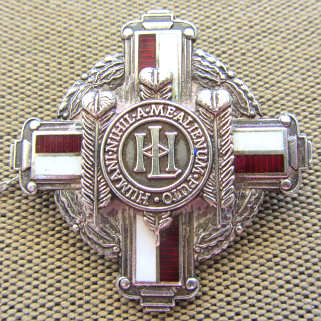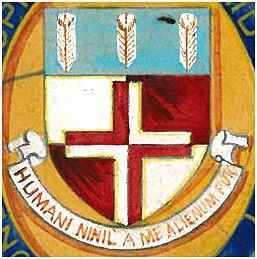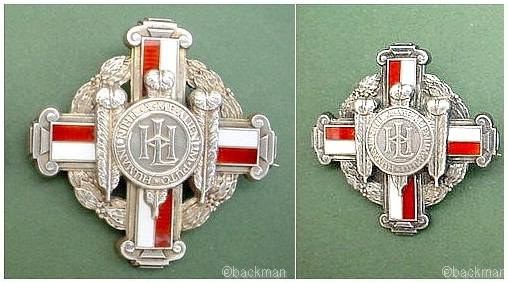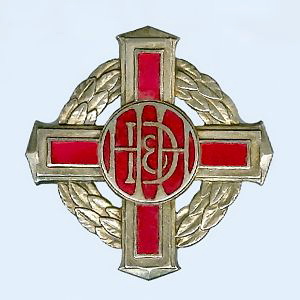| |
The London
Hospital Badge: History, Evolution and Identity. |
|
THE LONDON HOSPITAL BADGE
Fig 1
Last year, having seen several for sale on eBay and being the proud owner
of my own London hospital badge, I became more interested in the history
behind the badge - in the sizing, when they were first issued, and if
possible how many were made and issued.
Like many hospitals, the London did not have a badge until the 1920's.
In 1928 Miss Irene Paulin (daughter of Sir William Paulin - honorary treasurer
to the London Hospital) and a member of the hospital nursing committee, approached
John Pinches (1) (head of Pinches and co, (bought out by Franklin Mint in
1969 )) and asked him to design a badge for the trained nurses of the
London - insisting "that the badge be comparable with those of other
London Hospitals." The London hospital had no coat of arms at that point
in time, and it was decided that the nursing committee would postpone their
decision until a coat of arms was granted.
Eventually the London hospital coat of arms was designed by the garter
principal king of arms, the Richmond herald Sir Gerald Woods Wollaston.
The red and white colours in the design are those of the city of London (whom hold a
lease on the land on which a part of the London, now the Royal London,
still stands until 2066). The Richmond herald is reported to have
preferred an Ankh, the Egyptian sign of life and a type of cross. It was
felt that the red and white cross was suggestive of the Red Cross, and
also the city of London corporation. The silver wreath of laurel leaves
is considered to be a symbol of victory. (1)
The motto was chosen by Sir William Blizzard ( a famous London Hospital
surgeon), "Homo sum, humani nihil a me alienum puto" - "I am a human
being, I consider nothing that is human alien to me." After much research by
a Mr Oliver (1) there are still doubts about its origin. Eventually the
College of Heralds granted the coat of arms using Sir Williams Blizzards
motto, minus the first two words. (1)
fig.2
The first large style badge was made and presented to Queen Mary, at
that time president of the hospital, and it is documented that she wore
it on every visit. It was originally intended for League members only,
(1)
the league having been established in 1931. (We celebrated the 80th
anniversary with a lunch in the old medical college in September 2011).
By the league review publication number 2, (November 1932), there was
already controversy about the size and weight of the badge
(1) and reports
that it ripped the starched aprons, because of its size. (These records
are as yet elusive - Franklin mint reduced their records in 2004, and Fattorinis (who made the later badges including mine) only have records
from the 1980's - 1990's. They told me that the badges made then were 35mm.
What is incontestable is the fact that the earlier, larger badge weighed
32 grams - over an ounce - and had an extremely well engineered pin and
extremely sharp pin of over 47mm. Whilst the pin had secure fastenings
it did protrude around 3mm. Long enough, perhaps, to be seen as
potentially dangerous.
The Matron at the time - Miss Littleboy, (Matron
1931 - 1941) is reported to have hoped that the size
reduction (to 35mm sq) and cost: 27/6 to 16/- would encourage more
nurses to buy it. (1)
The original (earlier, larger) badge is seen on the left below,
whilst the newer, smaller and lighter version is seen on the right.
It is interesting to note that the larger, original design badge had
a perforated centre which the later design did not
have.
Perhaps an attempt to save weight - or silver and expense. Or perhaps it
really was just a more practical design....
Fig3. London Hospital Badge set.
The later design weighed 18 grams and was only 34mm wide,
and whilst the pin was still well engineered and still sharp it did not
protrude. It could be considered a much safer design. The badge was
otherwise unchanged. A superb example of craftsmanship.
"At the 3rd annual general meeting in July 1934 Miss Littleboy announced
that the change had been very popular and since altering the badge 115
had been ordered" (1)
The issue of the larger badge ceased about 1933 and issue of the smaller
badge commenced no later than 1934. It is assumed that the badge-boxes
illustrated below in Figs 5 - 7 was also changed around that time,
although when the final change to the Fattorini-type small plastic box
occurred is not yet clear. It seems fair to assume that the latter
occurred when Fattorini's took over the manufacture of the London
Hospital badge, as both the badges and boxes had previously been made by John Pinches.
Badge collectors may in interested in how many of each size have been
made, and Miss Job (known to many of us as Mrs Peggy Crispin) speculates
herself in her article in how many have been made since then.
(1)
Eva C E Lückes (Matron 1880 - 1919), may give us some clues to numbers in her letters to her
nurses (3) in which she states that certificates were gained by 103
probationers during 1899, with 95 in 1896 (for the 2 year course which
was first started at the London in 1880 as part reforms instigated by Miss
Lückes,
with paying probationers introduced in 1884). Miss Lückes was fiercely
opposed to the 3 year course that Mrs. Fenwick among others later
suggested, although she was in agreement with Miss Florence
Nightingale. (4)
In December 1942 the badge was finally presented to every nurse
successfully completing her training at the London Hospital along with
the hospital certificate of training. On becoming Matron in 1941, Miss Clare Alexander
(Matron 1941 - 1951)
(later
Lady Mann) requested that the House Committee of the London Hospital
should present every nurse trained at the London who became a State Registered
Nurse with the London
Hospital badge. (1)
The London, in common with many other training hospitals which did
not have a badge until the 1920's, allowed nurses to apply to have
their badges awarded retrospectively. It is interesting to note that the design of a badge often seems
to follow particular patterns - which may or may not be correlated to where the
badge instigators trained! Such as Florence's (Nightingales) image on the badges of
several "provincial hospitals"- a phrase used in the Burdett's listing
of hospitals. (5)
Elements of the London hospital badge can be seen in
that of the Haslemere and district hospital - where a tutor was a
Londoner, and similarly the badge of the Derbyshire sick children's
hospital has familiar elements - to us "Londoners".
(1) ( I am awaiting permission and an image from Derbyshire
Records Office - They may not allow me to include it in this article and
will charge).
Fig 4.
Haslemere & District Hospital Badge-RCN Archives
There are also similarities between both the Haslemere badge and that of
the West Park Hospital Badge, which has a blue cross with wreath around
the edge. I have not yet researched to see if there is any connection.
It would make an interesting study to trace the matrons of the hospitals
of the nation in the period of Florence Nightingale/ Eva Lückes and others
who trained at the "big" London Hospitals and were recruited in the
"provinces" to establish training schools and good nursing care. On my
brief perusal of several copies of Burdetts (5) it was clear that many
matrons nationally originated as nurses from London Hospitals. One such
nurse who I have started to research was Mary E Pinsent, who became a
matron of the Royal National Orthopaedic Hospital in Hanover Square - as
it happens also a "Londoner". There is such a list for "Nightingales" on
their league web site.
When visiting the Royal London Hospital Museum we had hoped to see both
a large badge and also an example of one of the boxes, however apart
from a small badge, there was only a small photographic image of a large
one being worn to compare. My small plastic 1980's Fattorinis box is not
quite the same as some of the earlier boxes! Two versions of which, the
earlier (for the larger badge) are shown left and center, and the later
version for the smaller badge (right) below:-
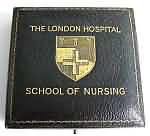
Circa 1930 - 34 |
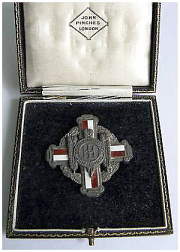 |
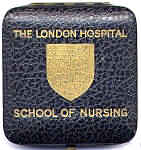
Circa 1933/4 -
1980's |
Fig. 5 - 7
In conclusion. It would appear that the large London Hospital badge was
only manufactured for a period of 2-3 years ( I am awaiting a reply from
the business research archives, to see if any records are being held by
them) and only possibly in very small numbers, given that 115 were
requested after the size change and that this was considered an
improvement in numbers. (1)
Likewise, the change in the design of the boxes followed the downsizing
of the badges. The original (older version) box being 182mm square and
weighing 48 grams whilst the later box was only 163mm square and
weighted 42 grams.
The very high quality of both badges and boxes was retained during the
years of production by John Pinches, although the presentation boxes
were changed dramatically during the Fattorini years (in common with the
majority of hospitals). The quality of the London Hospital badge has in
most respects been maintained, if not improved upon. The hallmarking of
the solid sterling silver 'badge of the three feathers', (the design
relating to the original tavern where the meeting was held to found the
hospital in 1740), which was absent from all
earlier (pre Thos Fattorini badges) has been corrected.
It was, and remains, an absolutely superb item.
References
1. 'History of the training school badge' Margaret Job, 1967
(Royal London Hospital Archives ref: RLHLH/NE/10/2).
2. Toye Kenning and Spencer .
3. "Letters to Her Nurses" Eva C A Lückes, vol 1 1896-1900(Royal London
Hospital Archives ref: RLHLH/N/7
4. wikedia: http://en.wikipedia.org/wiki/Eva Lückes
5. " Burdett's hospitals and charities: being the year book of
philanthropy and The Hospital annual".. Sir Henry Burdett 1901 RLHLH/
Illustrations
Figure 1. London Hospital Badge, the authors own, copyright
Sarah Rogers.
Figure 2. Original sketch of the London Hospital coat of arms as shown
in artists sketches ( circa 1935)still held by Toye Kenning and
Spencer. (2),
Figure 3. Large and small London Hospital badge set - copyright Peter 'backman'.
Figure 4. Haslemere & District Hospital Badge - number 633 Royal College
of Nursing Archives.
Figure 5 - 7. Two earlier London Hospital badge boxes. Copyright
schoolsofnursing.co.uk
Sarah Rogers 4/04/2012
* Beatrice Monk was Matron 1919
-1931.


